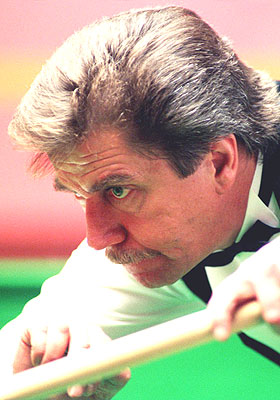Research makes perfect
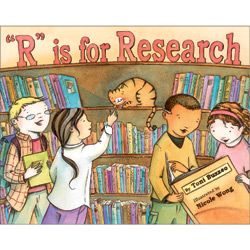 I’ll be the first to admit that I’m a rookie at this professional writing game. Indeed, if there’s one thing I’ve learned in my past year with the Canadian Press, it’s that I don’t know how much I don’t know.
I’ll be the first to admit that I’m a rookie at this professional writing game. Indeed, if there’s one thing I’ve learned in my past year with the Canadian Press, it’s that I don’t know how much I don’t know.
Sure, as a young Canadian male I’d watched more hockey than the average person. But there’s no way I’ve seen as much hockey as some of the big name experts like TSN’s Bob McKenzie and Darren Dreger of the CBC’s Scott Morrison, Don Cherry and Ron MacLean.
No, I definitely still have a lot to learn about the game and the sports journalism business in general.
The only acceptable recourse is to keep striving by working at my craft and doing research to broaden my knowledge base.
This is actually a personal belief that I’ve held for a long time. In fact, last month I was asked to speak to the current cohort at Centennial College, my sports journalism alma mater, and I made a point of talking about the importance of continuing the learning process even after school is done.
After all, sports journalists are required to interview athletes and coaches who have dedicated their whole lives to their sport. They know it inside and out. If we want to engage them and extract thoughtful quotes from them, we need to know what we’re talking about.
That’s one of the many reasons I decided to go to the World Hockey Summit. It was the ideal place to meet with hockey people at the grassroots level and learn about the issues facing the sport today. As you can tell from my four-day diary of the conference, it was an incredibly educational experience.
As I announced yesterday on my Twitter feed the Canadian Press has brought me back for another year as their junior hockey editorial assistant, and so I’m getting down to some serious research.
I’ve begun an email-writing campaign, introducing myself to all the media relations people of the Canadian Hockey League.
Whether it’s the head office here in Toronto, the regional offices of the Quebec Major Junior Hockey League and the Western Hockey League or the teams from Sydney, Nova Scotia to Prince George, British Columbia, everyone has or will hear from me.
The idea is to discover the stories behind each organization. Many of them have already sent me their media guides or are putting me on their mailing lists. Hopefully, these contacts and these press kits will help me come up with more and better feature stories and add further colour to my game stories.
Already I’ve benefitted from this initiative – this morning I was invited to listen in on the QMJHL’s season-opening press conference.
Amongst other pieces of news, league president Gilles Courteau explained that there is a gentleman’s agreement between the AHL and the Quebec-based association to not spread into New England. I was live Tweeting the call and when I mentioned that tidbit I got a big reaction from many followers.
I’m sure that all this work, all this research, will bear more fruit, I’m just not sure how. After all, I don’t know how much I don’t know. But that’s why I’m doing all this research – to try and improve myself as a journalist.
It’s time for a Women’s National Hockey League
 During the final day of the World Hockey Summit it became abundantly clear that Hockey Canada, USA Hockey and especially the National Hockey League need to become more proactive in the growth of women’s hockey.
During the final day of the World Hockey Summit it became abundantly clear that Hockey Canada, USA Hockey and especially the National Hockey League need to become more proactive in the growth of women’s hockey.
It’s something that has been at the back of my mind since the Winter Olympics in Vancouver last February – how can an exciting game like women’s hockey only really be seen on TV every four years? What can be done?
Outside of the collegiate game in the United States and Canada there is no forum for elite women’s hockey. Even at the amateur level there are many municipalities that don’t have leagues for female players, and at the World Hockey Summit there were stories of towns that won’t let women use the arenas, period.
Further, there is no junior hockey for ladies - although women are allowed to play in the three leagues that comprise the Canadian Hockey League.
At the professional level there have been several attempts at running leagues, including the Canadian Women’s Hockey League that has teams in Montreal, Mississauga, Burlington, Brampton, Vaughn and Ottawa.
The CWHL competes for the Clarkson Cup against teams from the Western Women’s Hockey League. The WWHL has franchises in Calgary, Edmonton, Winnipeg, Strathmore and Minnesota.
Although I admire these leagues ambitions, they’re unstable with teams folding or relocating constantly. Other leagues like them have collapsed under the financial and administrative strains of running a professional association.
This is where the NHL needs to step in, and form a WNHL, much like the National Basketball Association’s WNBA, to market and promote a high-calibre female version of hockey.
Like the WNBA model, all the teams could be owned by the NHL or its franchises at first, and as they become more solvent be sold to third parties. Every team would be associated with an NHL or American Hockey League franchise to guarantee cheaper access to facilities and to enable cross promotion.
It would be an easy sell to have a NHL/WNHL double-bill in several traditional hockey markets like the Original Six, in the six Canadian NHL cities and a few other hotbeds like Minneapolis.
Further, when I threw it out to my Twitter followers last week, reader @katylalonde pointed out that there are several locations begging for hockey like Winnipeg, Kitchener, Hamilton and Quebec City. It would be a smart move for all four municipalities to invite a WNHL franchise to their rinks and prove that their arenas are viable venues for professional hockey.
Of course, such an initiative would have to be supported at the amateur level. Hockey Canada, USA Hockey and regional associations would need to do more to promote the women’s game at the amateur level. But with professionals serving as role models, it shouldn’t be too hard.
This is the kind of program that is prime for implementation - all it would takes is a motivated NHL willing to capture the interest of a whole new market of hockey fans.
World Hockey Summit – Day 4
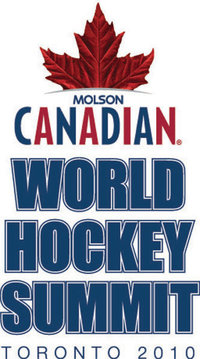 The fourth and final day of the 2010 World Hockey Summit focused on moving hockey forward and continuing to spread the good word about Canada’s favourite sport.
The fourth and final day of the 2010 World Hockey Summit focused on moving hockey forward and continuing to spread the good word about Canada’s favourite sport.
After an early breakfast the conference met in the Toronto Sheraton’s downstairs hall to listen to players, coaches and organizers speak about the movement to promote women’s hockey.
Like the previous day’s sessions on the Olympics and a World Hockey Agenda, all the members of the panel acknowledged that the 2010 Vancouver Games had done wonders for their sports’ public profile.
However, unlike Wednesday’s slanging match, keynote speaker Hayley Wickenheiser and the panel of Mel Davidson, Mark Johnson, Arto Sieppi, Angela Ruggiero and Peter Elander all agreed that women’s hockey had to return to the Olympics as well as stage more international and even professional matches.
Ruggiero made an important point about high calibre women’s play: as a member of Team USA she plays, on average, ten games per year. That’s it.
Once a player graduates from the NCAA, there is no viable professional women’s league. An individual looking to improve their game beyond the confines of a varsity program has to arrange her own ice time and practicemates, a surprisingly difficult task.
This lead to a lengthy discussion amongst the panel, and later amongst the break-out groups, about how to go about creating a professional women’s league that would allow elite female players to hone their skill and provide aspiring hockey players with ready-made heroes.
Promoting hockey to women dovetailed perfectly with the afternoon’s session on Growing Participation in hockey.
Tommy Boustedt of Sweden, Sieppi (again) of Finland, Scott Smith of Hockey Canada and Pat Kelleher of USA Hockey all discussed the particular challenges of promoting hockey in their respective countries.
Both Sweden and Finland focus on education of coaches, players and parents through intensive hockey schools open to all amateur players, while USA Hockey is concerned with branching out past the Three Ms: Michigan, Massachusetts and Minnesota.
Canada, of course, doesn’t have to worry about popularizing the game or breaking into new markets. Instead, their focus is on developing accessibility for low-income families and New Canadians as well as promoting women’s and sledge hockey.
Dr. Paul Dennis of the Canadian Hockey League, Cyril Leeder of the Ottawa Senators and John McDonough of the Chicago Blackhawks also contributed by addressing how their organizations interact with local communities to promote hockey and win over new fans to the game.
Although it was the least exciting of the presentations, that final session served as a fitting end to four days of hockey talk. It put a positive spin on the Summit and insured that the hundreds of delegates would be energized to go out and continue their hard work.
World Hockey Summit: Day 3
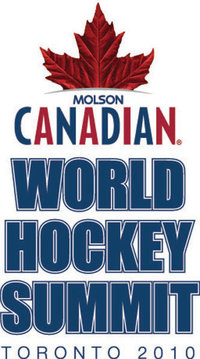 Debate over the National Hockey League’s role in international hockey, especially the Winter Olympics, built to a crescendo at the World Hockey Summit yesterday.
Debate over the National Hockey League’s role in international hockey, especially the Winter Olympics, built to a crescendo at the World Hockey Summit yesterday.
International Ice Hockey Federation President Rene Fasel had started thumping the war drums on Tuesday when he warned the NHL that they would expand to Europe “over his dead body”.
During that same question and answer session with TSN’s Gord Miller he called for professional hockey players to play at the 2014 Winter Olympics at Sochi, Russia.
Wednesday morning there was an evaluation of the 2010 Olympics, with Fasel, Vancouver Organizing Committee CEO John Furlong and International OIympic Committee member Timo Lumme speaking about the great success and popularity of hockey at this year's Games.
All three emphasized that the 114 million worldwide viewers of the USA-Canada men’s hockey final had been drawn, in part, by the fact that it was a best-on-best game that featured NHLers.
After the keynotes were done, Miller, acting as moderator, allowed IIHF member Igor Kuperman, sports marketing guru Brian Cooper, Detroit Red Wings general manager Ken Holland, Ottawa Senators captain Daniel Alfredsson and New Jersey Devils captain Jamie Langenbrunner to respond.
Not surprisingly, all five panellists supported the NHL’s return to the Olympics, with only Holland showing any kind of hesitation. The successful GM had many concerns about scheduling and injury issues affecting the success and health of his professional club.
When discussion broke out amongst the hundreds of delegates in attendance, there was an easy consensus that the NHL and Olympics need each other for the fans and the good of the game.
After lunch, NHL Commissioner Gary Bettman had a Q+A with TSN’s Pierre Maguire. During the interview Bettman repeatedly said there were pros and cons to sending his players to Sochi.
“We haven’t said ‘no,’” said Bettman. “And anybody who suggests that we’ve made a decision or suggests I’m anti-Olympics doesn’t get it, because what we’ve been simply saying is, ‘it’s a mixed bag.’”
Bettman stressed that he was commissioner when the NHL first started playing in the Olympics at Nagano, Japan, four cycles ago and that he has always been interested in exposing the sport to as many people as possible.
Many had expected that Bettman’s half-hour session was going to be the most heated event of the day. However, it was the follow-up discussion of a Global Event Agenda that was really contentious.
Moderated by Darren Dreger, the panel began with a thoughtful presentation by Edmonton Oilers associate coach Ralph Krueger, who had served as head coach of the Swiss national team at the Vancouver Olympics.
Krueger proposed a new schedule for international events, featuring the Olympics every four years, a World Hockey Championship during the intervening years and an under-23 world championship during Olympic years.
He also suggested that the Victoria Cup, an annual club championship between two European teams and two NHL teams, should be revived.
Miller then opened the floor to the panel of NHL Deputy Commissioner Bill Daly, Kontinental Hockey League President Alexander Medvedev, Team USA and Toronto Maple Leafs GM Brian Burke, NHL alum Anders Hedberg, former NHL goaltender and prominent NHLPA member Glenn Healy, NHLPA representative Mike Ouellet and IIHF member and broadcaster Paul Romanuk.
Although things began reasonably as each panellist said their piece, Fireworks ensued when they had the chance to rebut each other.
Generally speaking, Burke and Daly presented the case for the NHL staying out of the Olympics, highlighting that it put teams’ assets – the players – at considerable risk of injury. They were also concerned that the interruption in the professional season damaged the momentum of small-market teams.
“The Olympics don’t hurt the Toronto Maple Leafs, it doesn’t hurt our business model,” said Burke, the former GM of the Mighty Ducks. “But in Anaheim it does. In Nashville, it does. In Florida, it does.”
They were opposed by Healy and Ouellet, who as representatives of the players’ association, felt that their constituency should be allowed to play when and where they wanted, and that practically all NHLers would love to play at the Olympics.
Panellists outside of the labour politics of the NHL like Medvedev, Hedberg and Romanuk also chimed in with their concerns, although all three were adamant that the Olympics should be a “best-on-best” tournament.
The debate laid bare many of the tensions at the highest levels of hockey.
Everything from the ongoing labour disputes between the NHL and NHLPA, the lack of communication between the NHL and IIHF, the competing styles and values of European and North American hockey as well as the emergence of the KHL as a threat to NHL supremacy were all on display.
There were many dramatic moments, including Healy wondering aloud why Burke cared so much about when the World Hockey Championships were scheduled, since the Maple Leafs are always available when the tournament begins in April.
Alliances also shifted quickly in the swirling debate. When a doctor from the IIHF spoke from the floor to correct Healy’s impression that the quality of medical care provided at the Olympics is sub-par, the former Toronto goaltender saw his nemesis Burke leap to his defence.
Similarly, when another delegate called out Burke and Daly saying that it was a simple issue and that he was sick of hearing excuses about NHLers playing in the Olympics, Ouellet and Healy both allowed that it was a complex issue.
Burke was the most energetic debater throughout, taking on all comers from the stage and the floor of delegates, although Daly, Ouellet and Healy were very active as well. It was an exciting and intriguing show that had delegates buzzing for the rest of the day.
Today’s topics will be Women’s Hockey in the morning and Growing Participation. It’s hard to imagine that those panels will be nearly as heated, but you never know.
World Hockey Summit: Day 2
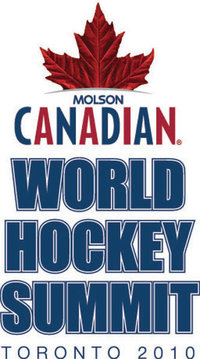 After nine hours of panels, group work, questions and answer periods as well as informal discussions over food, one thing is clear at the 2010 World Hockey Summit: the amateur hockey system has to change.
After nine hours of panels, group work, questions and answer periods as well as informal discussions over food, one thing is clear at the 2010 World Hockey Summit: the amateur hockey system has to change.
Whether it was cautions from Dr. Steve Norris or Dr. Mark Aubry on the overly demanding training in youth hockey during the morning’s Player Skills Development session or the dire warnings of Czech National Program Director Slavomir Lerner of the talent drain from Europe to North America, it was plain as day that things need to change.
Although it’s difficult to sum up nearly six hours of presentations, the general consensus was that minor hockey associations are too focused on turning young players into National Hockey League superstars, sapping the game of its fun and making it excessively dangerous.
As panellist Brendan Shanahan said “How come I don’t hear about kids playing shinny anymore?”
The speakers spoke of multiple concussions to eight and ten year-olds, massive dropout rates in children’s hockey (44% of American hockey players have stopped playing by the age of nine) and a dwindling European junior system robbed of its best talent by the superior Canadian Hockey League.
During question and answer periods as well as in break-out discussion groups the delegates and officials in attendance at the WHS brainstormed ideas that could make amateur hockey fun again for the casual player, while creating a more practical Long Term Athlete Development plan for adolescents and teenagers who want to become professionals.
The idea that was most popular – garnering a round of applause from the Air Canada Centre’s floor when it was suggested – was raising draft eligibility from 18 to 19.
Many groups of delegates had come up with similar concepts including raising the draft age to 20 or forcing players to stay in midget for a minimum of two years and junior for three. A freeze on all international movement at the junior level was also a common theme.
One radical suggestion was to raise draft eligibility to 19, but allow NHL teams to take 18-year-old players at the cost of two draft picks. So a Sidney Crosby-type player would have cost the Pittsburgh Penguins their first and second-round draft picks.
It was an informative and exciting day of hockey talks, and I’d strongly recommend that you follow the above links to see video of the panel discussions. Also, if you want up-to-date quotes from the day’s events follow me on Twitter.
Today’s discussions will start with an evaluation of hockey’s role at the 2010 Vancouver Olympics, then a Q and A with NHL commissioner Gary Bettman and then finish off with an afternoon session on Establishing a Long-Term Global Event Agenda.
World Hockey Summit: Day 1
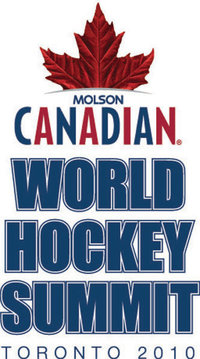 As I mentioned on my Twitter feed, I will be attending the 2010 World Hockey Summit this week, with lots of LiveTweeting on my feed and daily blog posts summarizing what I’ve learned.
As I mentioned on my Twitter feed, I will be attending the 2010 World Hockey Summit this week, with lots of LiveTweeting on my feed and daily blog posts summarizing what I’ve learned.
Hockey Canada is organizing the conference, bringing together hockey organizers, players and coaches from around the world to discuss the future of the game and improve on safety.
In the words of Hockey Canada President Bob Nicholson, the Summit will “provide an inclusive forum to table the most pressing questions surrounding our game and work together to find implementable solutions.”
Day 1 was very straightforward. It was basically clear from nine until five, giving all the attendees a chance to register and settle into their accommodations in downtown Toronto.
Tonight there will be a Hot Stove Session at the Hockey Hall of Fame where four panels rotate from room to room, discussing Contracts and Transfers, Agents’ Role in Working with Young Players, State of the Game and Comparisons of the International and North American Game.
Unfortunately, I’ve got previous commitments for tonight, so I’ll be missing out on those talks. They do sound very interesting though, and I’ll try to get my hands on a recap of the discussions to share here.
Tomorrow will start with a continental breakfast at the Air Canada Centre, home of the Toronto Maple Leafs and the National Hockey League’s Canadian office. There’ll then be a three hour session on Player Skills Development.
At one in the afternoon, Rene Fasel, the President of the International Ice Hockey Federation, is going to have a half-hour Q+A period.
Next up is the session that I am most interested in: Junior Development in the Hockey World. The reason is fairly obvious – as junior hockey editorial assistant for the Canadian Press, this is my wheelhouse.
It’s going to be a lot of fun and interesting week. Please, check back here tomorrow night or my Twitter feed throughout the day to see what it’s all about.
My latest for Hockey Prime Time
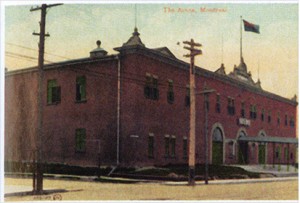
Recognize this place? It's one of my top 10 arenas in NHL history. Hover your cursor over the picture for the answer.
As long-time readers of this blog know, I’m involved with a hockey website called HockeyPrimeTime.com. It’s a great site that offers up news and analysis of the National Hockey League as well as hockey around the world.
Normally I’d be writing some notebooks on the comings and goings of the NHL’s Northeast division.
However, since there’s no hockey on right now we’ve been putting together a series of Top 10 lists. I’ve contributed two articles to the project and I’m really proud of both of them.
Most recent was my list of the Top 10 Arenas in Hockey History. A few recent rinks that made the list are Toronto’s Air Canada Centre, Detroit’s Joe Louis Arena and Philadelphia’s Spectrum.
My other Top 10 list was posted about a week ago and breaks down the Top 10 Most Influential Individuals in NHL history. I had a blast writing it. Like my work with Canada’s Sports Hall of Fame I got to combine my interest in history with my love of hockey.
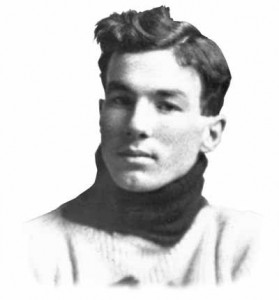
Recognize this guy? He's #9 on my list of the most influential people in NHL history. Hover your cursor over the picture for his name.
I think my list of ten influential people will surprise some people and hopefully it’ll also introduce people to some players and builders who don’t get enough credit for shaping the modern NHL. I also feel that some people will be surprised at who is at the top of the list as the most influential man in NHL history.
In any event, it was a lot of fun putting these lists together.
What do you think the most significant hockey arenas are in hockey history?
What about influential people? Do you think I missed anyone?
Back to the blogging!
 It’s been weeks since I last posted on ye olde blogge, thanks largely to my ongoing involvement with the development of new content for Canada’s Sports Hall of Fame.
It’s been weeks since I last posted on ye olde blogge, thanks largely to my ongoing involvement with the development of new content for Canada’s Sports Hall of Fame.
But since I was waiting on some editorial turnaround, I decided to go on a baseball pilgrimage of the northeastern United States, touring the baseball Hall of Fame in Cooperstown, N.Y., the new Yankee Stadium and Citifield in New York City and then on to the oldest stadium in the majors, Boston’s Fenway Park.
It was at the home of the Red Sox that I proposed to my fiancé Katy, capping off an amazing vacation.
But I owe you, my readers, an apology. I was so busy planning my trip and proposal that I didn’t do my due diligence and post links to my most recent writing before leaving for the U.S. I’m sorry because I like to keep you all updated on my various projects.
Recently, I’ve been doing some pretty exciting work for HockeyPrimeTime.com, including a draft preview, a free agent preview and a notebook, all on the National Hockey League’s Northeast division.
Even worse, my holiday matched up with one of the craziest fortnights in sports history. Let’s recap with a few quick hits.
Only Japanese officials from now on – Yes, early favourite Spain did win the World Cup on Sunday. But their victory, along with the results of many other games, was tainted by terrible officiating.
What was particularly galling in the championship game was that Spanish forward Andrés Iniesta’s winning goal was made possible by an undeserved goal kick - the ball had clearly been deflected out of bounds by a Spanish defender.
By my eyes, the only consistently strong officials hailed from Japan, odd for a nation that has only recently taken to soccer. The 2010 was a huge opportunity for FIFA to expand its brand to North America, a chance that was blown by the officials.
Iroquois Nationals might not make FIL World Championship – In a completely bizarre situation, the Iroquois Nationals team is currently unable to attend the lacrosse world championship in Manchester, England later this week.
Inside Lacrosse editor-in-chief John Jiloty explains:
“The issue centers around the Nationals (a group of 42, all members of the Six Nations of the Iroquois Confederacy) traveling on their Haudenosaunee passports. For more than 20 years, they’ve traveled on these passports with no problem. But the United Kingdom will only allow them into their country if the United States will let them back in. And as of Friday, the Iroquois did not have that assurance from the U.S.”
This is totally nuts. Yes, they’re travelling on a very specialized kind of passport, but the Iroquois are all Canadian and American citizens and upstanding ones at that.
The idea that they might miss out on playing a sport they invented because they can’t return to a continent that they’re indigenous to is pure lunacy.
The Decision LeBacle – I know, I know. Everyone and their aunt has already talked about LeBron James’ one-hour ESPN special where he callously announced his move to the Miami Heat. But how can I not talk about it? It will undoubtedly become one of the turning points of sport in the past 50 years, not just because that hour of television was a public relations disaster, but because it’s going to change the face of free agency in the National Basketball Association, and probably other major league sports as well.
I’ve got a lot more to say on all these topics, but I’ll leave you on that note. Blogging on weekdays has returned! Brap-brap.
Knowledge bomb – Canadian Sports History
As I mentioned two weeks ago, my I’ve been very busy doing some freelance work for Canada’s Sports Hall of Fame. The past two weeks have been spent researching and selecting the top two or three defining moments in the lives of 96 honoured members of the Hall.
Along the way I’ve learned a lot of quirky and interesting facts about some of Canada’s greatest athletes.
Snooker master Cliff Thorburn was the first person in world championship history to record a perfect break of 147.
For those of you who’ve never played snooker: a perfect score of 147 means that he sank every cherry ball on the table and was able to follow up with the black ball (the most valuable of the coloured balls) every time. Further, he did it without his opponent ever sinking a single ball. It’s an incredible feat of strategy, foresight and skill at any level, let alone in a world championship.
Unfortunately, Thorburn went on to lose the final match of the tournament to Steve Davis, but that doesn’t diminish his accomplishment in the first round against Terry Griffiths.
Famed strongman Louis Cyr’s records are hard to verify since few were recorded and most were hyped and exaggerated by promoters. However, he definitely set a record in 1895 by lifting 4,337 pounds on his back. As impressive as that is, the story that struck me was that at the age of 18 Cyr won a strongman competition in Boston by lifting a horse off the ground.
Don’t get me wrong, no horse weighs as much as 4,337 pounds, but they do, you know, move around and squirm. Particularly if they’re uncomfortable, like if someone was picking them up off the ground. Trying to lift something as heavy as a horse while it is moving is way more impressive than a dead lift, no matter the disparity in weight.
Finally, as many hockey fans know, Henri Richard holds the record for most Stanley Cup wins as a player. His 11 championship rings is a mark that may never be passed with the salary cap-era of the National Hockey League in full effect.
What most people don’t know is that at the time of Richard’s retirement he had won more Stanley Cups than he had had birthdays. Since he was born on February 29th, 1936 – a leap year – he had only celebrated his actual birthday nine times before his retirement during the 1974-75 season.
Anyway, thought I’d just drop some knowledge. I should have time to do some more posting as the week continues.
Cormier’s charges are a bitter pill to swallow
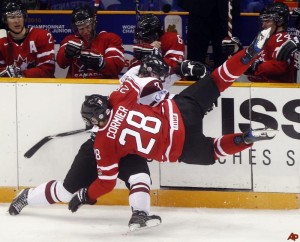 Patrice Cormier of the Quebec Major Junior Hockey League’s Rouyn-Noranda Huskies continues to suffer the consequences of his actions in January.
Patrice Cormier of the Quebec Major Junior Hockey League’s Rouyn-Noranda Huskies continues to suffer the consequences of his actions in January.
The former captain of Canada’s world junior team has now been charged with assault causing injury months after he knocked Mikael Tam of the Quebec Remparts to the ice with an elbow to the head.
Cormier was suspended by the QMJHL for the rest of the season, a punishment that was supported by the National Hockey League and the American Hockey League, preventing the New Jersey Devils’ prospect from playing out the rest of the season as a professional.
The hit to Tam’s head certainly merited a season-long suspension. I said it at the time and I still believe that it was a just punishment.
Criminal charges, however, take things to a whole new level.
There is going to be a huge outcry over this – both positive and negative – and then gas will be poured on the issue during the first intermission of tonight’s broadcast of the Vancouver Canucks-Chicago Blackhawks game when the CBC’s Don Cherry is given some airtime on Coach’s Corner.
Hits to the head, French-Canadian players and the law weighing-in to judge hockey? Oh man. This is like the perfect storm of Cherry Pet Peeves.
In any event, a ton of ink is going to be spilled in over the possibility of a hockey player doing time for an act on the ice.
Of course, the big question is – should Cormier even be charged in the first place? It pains me to say it but, yes, he should.
As evidenced by the strong reaction of the Canadian Hockey League, the QMJHL and the NHL that play was definitely outside the normal parameters of safe play. Further, there’s an argument to be made that Cormier did it on purpose. The video evidence certainly makes it look like Cormier purposely targeted Tam.
Despite the protests of some fans, there is precedent for the law getting involved in overly-physical hockey disputes. In fact, it’s happened on 14 different occasions since 1900.
If that happened on the street it would undoubtedly result in the victim pressing charges, so why shouldn’t it on a rink?
It’s a bitter pill to swallow, but for justice to be completely done, Cormier must go through a criminal trial.
